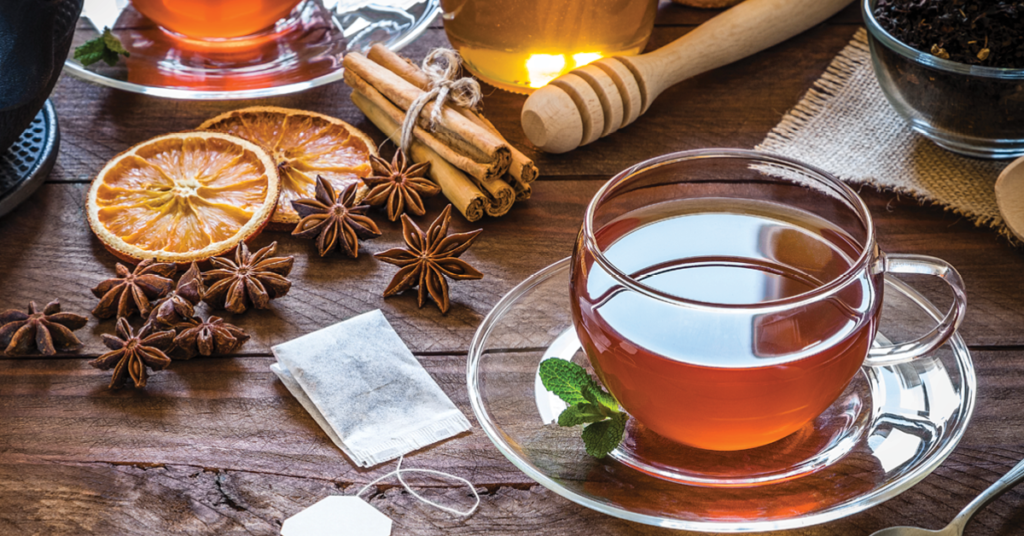
Tea Up for Well-Being
Ellie Wilson
MS, RDN
As the evenings turn cooler, our beverage choices also shift to warmer temperatures and more comfort and health-oriented drinks. Tea is the most popular beverage in the world, second only to water, and has a range of flavors, benefits, and culinary applications.
Tea has a simple recipe – water and some form of the leaves of the Camelia Sinensis bush, it is most often made with hot or warm water, but can be made with cool water, such as “sun tea”. That simplicity earns it a spot on the list of whole foods, or more accurately, whole food-derived drinks. Interesting to note that America is the primary country where tea is enjoyed cold – the demand for functional beverages that are portable and personal has created a unique opportunity for tea as a grab-and-go beverage. Approximately 75 – 80% of tea consumed in America is iced. ¹
The first written records of tea as a medicinal beverage were found in China, around the 3rd century A.D. Modern research has been able to identify specific compounds that may have health benefits, including polyphenols such as flavonoids, theaflavins and catechins, all antioxidants. Observation studies connect 2 -3 cups of tea per day to reduced risk of premature death, heart disease, stroke and type 2 diabetes. More research must be done to define intake and specific health impact, but tea has a place on the table for traditional teetotalers and health seekers alike.
Generally, caffeine content of a cup of tea is 50 mg or less, half the content of an 8 oz cup of coffee. ² Time brewing and form of tea also impact caffeine content. Tea assists with hydration, and contains the amino acid theanine, which research hints supports brain health. This makes it a perfect beverage for that afternoon energy-seeker, busy parents recharging between work and evening family activities, or an end-of-day stress soother.
Tea is also riding the innovation wave as more functional beverages that include nootropics, ingredients that enhance energy, focus, and relaxation, or added vitamins and minerals. Culinary innovations include using flavored teas (such as green tea with lemon) as a poaching liquid for seafood or chicken, or macha (green) tea powder as an ingredient in baked or dessert items. Tea is even in barbeque sauce!
I had the opportunity to see a tea plantation and enjoy a tea ceremony in Japan. The evergreen shrubs were beautiful and carefully tended. Tea grows at higher elevations in many Asian countries – it was a beautiful landscape and is where I was first introduced to green tea.
Tea flavors are shaped by the terroir or soil/climate/altitude of the place it is grown. ³ They are also defined by the part of the plant that it is made from, and the types of processing those plant elements are subjected to. Finally, they may be enhanced by essential oils, or combinations with other plants, such as herbs or spices (such as Chai, a tea spiced with cardamom and cinnamon). Tea truth – beverages made with herbs, spices, flowers and other plants that do not include the Camelia Sinensis leaves are not teas – they are tisanes. That term is more technical – “herbal tea” is a more consumer-friendly description and has become the more common term used for those brewed beverages.
Take some time to explore the amazing world of tea with the many varieties and flavors you can find in stores. You will find yourself in good company – 159 million Americans enjoy tea each day! ⁴
¹, ⁴https://www.teausa.com/teausa/images/Tea_Fact_2021.pdf
²IFIC, accessed 9/7/22, https://foodinsight.org/coffee-and-tea-can-hydrate-too/
³Tea Aroma Formation https://www.sciencedirect.com/science/article/pii/S221345301500018X


